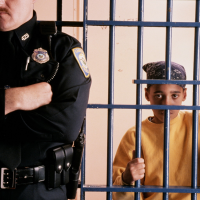Is It Really Necessary to Automatically Shackle Juveniles for Court Appearances…and Keep them in Solitary Confinement?
 (photo: Getty)
(photo: Getty)
Advocates for juvenile offenders are pressing for reforms in the criminal justice system to reduce the frequency of shackling youths in the courtroom or placing them in solitary confinement once in prison.
By some estimates, up to 100,000 young people, even those charged with non-violent offenses, walk into courtrooms handcuffed or in leg irons, or both. “Children as young as 9 have been shackled, as have children who have been abused by their parents,” Stacy Teicher Khadaroo wrote at the Christian Science Monitor.
Critics of this practice say the use of the restraints is contrary to the rehabilitative purpose of juvenile court, and can hurt, humiliate and traumatize children.
“The potential harm associated with shackling far outweighs safety concerns in the vast majority of cases – and in the rare instances restraints might be necessary – the decision to use them should be made by the judge,” Shawn Marsh, who oversees juvenile law issues for the National Council of Juvenile and Family Court Judges, said earlier this month, according to the Monitor.
Advocates have lobbied lawmakers at the state level to adopt reforms to do away with automatically restraining youths. Others are challenging the policies through lawsuits. Twenty-one states have legal limits on shackling practices.
Once juveniles are sent to prison, they can be subject to another form of abuse by authorities. Many sentenced as adults are forced to serve their time in solitary confinement to keep them safe from the general prison population.
Although the practice may keep them from physical harm, it can create mental health issues such as depression or post-traumatic stress disorder. The American Academy of Child and Adolescent Psychiatry called for an end to putting children in solitary confinement three years ago.
“There is plenty of research showing that solitary causes far more harm to kids than to their adult counterparts,” Dr. Louis J. Kraus, chief of child and adolescent psychiatry at Rush University Medical Center in Chicago, told The New York Times. “It induces anxiety, and it increases the risk of suicide,” he added. “It is barbaric. I can’t emphasize that enough.”
-Noel Brinkerhoff
To Learn More:
Momentum Builds to Stop the Automatic Shackling of Juveniles in Court (by Stacy Teicher Khadaroo, Christian Science Monitor)
NCJFCJ Resolves to Stop Shackling of Children in Juvenile Court (National Council of Juvenile and Family Court Judges)
Juvenile Shackling Reform in the United States – 2014 to Present (Campaign Against Indiscriminate Juvenile Shackling) (pdf)
Locked in Solitary at 14: Adult Jails Isolate Youths Despite Risk (by Timothy Williams, New York Times)
Feds Agree to Limit Shackles for Immigrant Detainees, but Just in S.F. Court (by Ken Broder, AllGov California)
- Top Stories
- Unusual News
- Where is the Money Going?
- Controversies
- U.S. and the World
- Appointments and Resignations
- Latest News
- Trump to Stop Deportations If…
- Trump Denounces World Series
- What If China Invaded the United States?
- Donald Trump Has a Mental Health Problem and It Has a Name
- Trump Goes on Renaming Frenzy






Comments